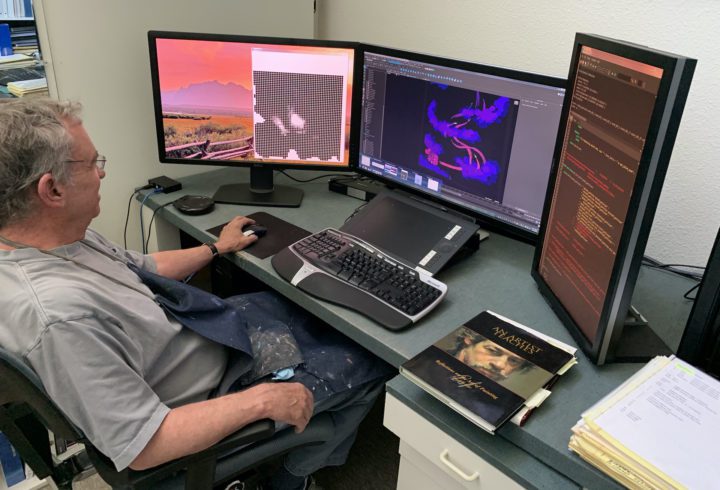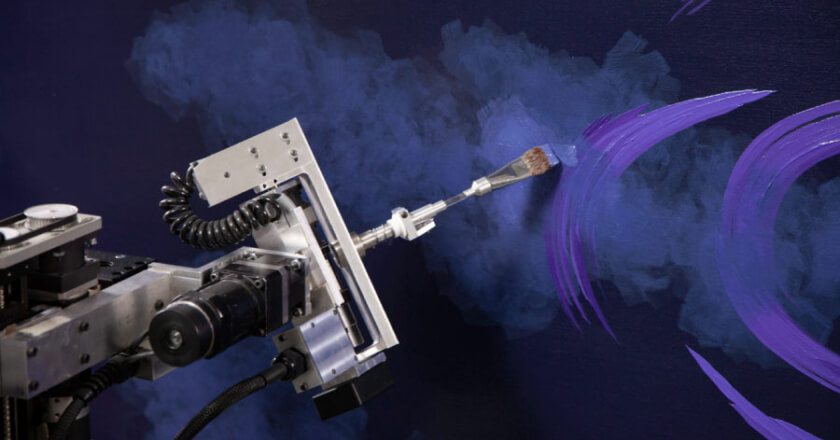Get Inspired
Build the life you love. Learn more about fusioneering:

Posted on February 8, 2023 in AI Technology
At Harvard University in 1977, Paul Kirby dreamed of a fusion of disciplines wherein computer science would redefine how art is made. Nearly fifty years later, Paul’s creation, Dulcinea – a painting robot – works tirelessly producing thought-provoking paintings conceived by man and perfected by AI. In that time, computer science has advanced exponentially, and with it has come powerful innovations in the ways artists are able to create.
Related: 5 Ways AI Has Changed Your Daily Life
Analog, hand-made art is still incredibly important in our modern age, but such processes, are often cost-prohibitive, time consuming, and unforgiving of mistakes. Digital tools have revolutionized art workflows, cut production times, and introduced a level of flexibility and ease to artists throughout the world. Programs are available for everything from animation, drawing, and design to music production, writing, and filmmaking. Tiresome, tedious tasks – like manually cutting film celluloid or having to erase drawings by hand – have been streamlined with the vast swath of digital suites available to creators. New art forms and art genres, such as video games or electronic music, have even been born from experimentation with the astonishing digital tools at our disposal.
In addition to revolutionizing the manufacturing industry (through less energy use, less waste, ease of use, and faster production times), 3D printing has also been a boon for the art world. Independent sculptors now have a cost-effective home solution to rapidly produce and sell their work, and hobbyists have a whole new avenue to acquire models and miniatures for painting.
Additionally, modern inventors and innovators like Paul Kirby now have the ability to rapidly prototype new tools and parts to use in their work.
Computer-generated imagery has become a staple of filmmaking across the world, allowing big budget movies to create stunning effects, characters, and settings, and enabling independent filmmakers to add scale and production value to low budget films. People like George Lucas and James Cameron have been using the technology to craft whole alien worlds never before glimpsed by man, but even practical effects-driven films like those of Christopher Nolan and David Fincher still utilize large amounts of CGI to cover mistakes, solve production headaches, and achieve the exact look and feel the director wants. These days, it’s hard to find any major motion picture that hasn’t used CGI in some capacity – even if it was only to remove a tattoo from an actor’s arm.
Related: Discover the Man Who Invented Movie Effects
Beyond the powerful art creation and editing programs, information technologies have created a colossal shift in the way art is created: it’s vastly easier for artists to communicate. Business innovations of the internet age, like email and video conferencing, have made it more convenient than ever for collaborators and contributors to communicate with one another. Artists are also able to connect with audiences more than ever before, with social media, message boards, and online communities serving as the new Greek forum for our times.
Recently, AI in art – and AI’s ability to create art – have become widespread discussion topics. A myriad of AI programs exist that can write text or produce artistic images from prompts of only a few words.
AI-generated images only exist non-tangibly in a digital space, and are produced through machine learning without the artistic oversight and vision of a real human being – and that raises the question of if these programs are really making “art,” or something else. A key component of art’s emotional resonance is in its ability to communicate meditations on the human condition from person to person. A computer program – at this point in time – is unable to ruminate on life, emotion, or existence.
But what about Paul Kirby’s work with the painting robot Dulcinea? Dulcinea is physically painting the canvas, and computer programs are generating the unique eccentricities and surprises in the brushstrokes, but the work is still human-guided, with one man’s vision driving the meaning behind each painted piece. It’s Paul’s knowledge and appreciation of art history that decides what a painting will be about and what elements it will feature, with the computer components acting as tools and collaborators – and not driving forces. Furthermore, the Kirby Foundation believes that art is most evocative when it is physical and tangible, with textured brushstrokes and layers of paint on canvas – after all, isn’t seeing the Mona Lisa in real life is a different experience than seeing it represented as a JPEG?
It’s important to remember that AI is – in its current state – a tool, and not a crutch. Computers are vastly powerful machines that can facilitate new and easier ways to create… but they’re still no substitute for the human creative spirit.
What do you want to create? How will you do it?
Need some inspiration or mental stimulation? Follow the Kirby Foundation on Instagram and Facebook, and join the Kirby Foundation mailing list for more on art, AI, technology, and the future.
Want to know how inspirational person Paul Kirby conceived of a world where art and science would work together in amazing ways? Check out the award-nominated short documentary.
Are you interested in hearing the complete story of Paul and Dulcinea? Watch the video (nominated for Best Short Film at the 2021 Vail and Portland Film Festivals) for more info.
Want to be the first to know about every exciting new project at the Kirby Foundation?
Join Our Mailing ListBuild the life you love. Learn more about fusioneering:
Why pick which passion you should follow? Fusioneering allows you to cultivate many interests into something innovative and revolutionary.

Meet Paul and explore how blending your interests can empower you to follow your enthusiasm and bring your passions to life.